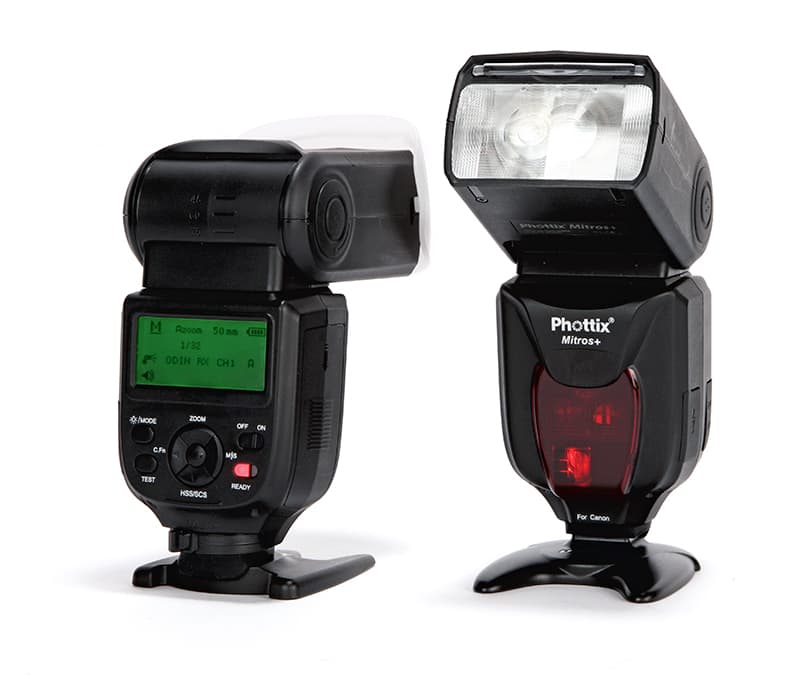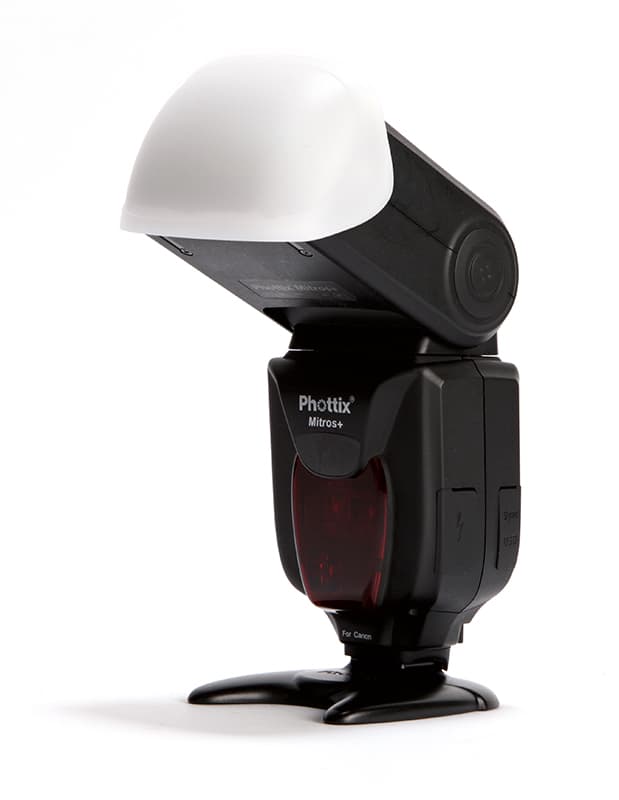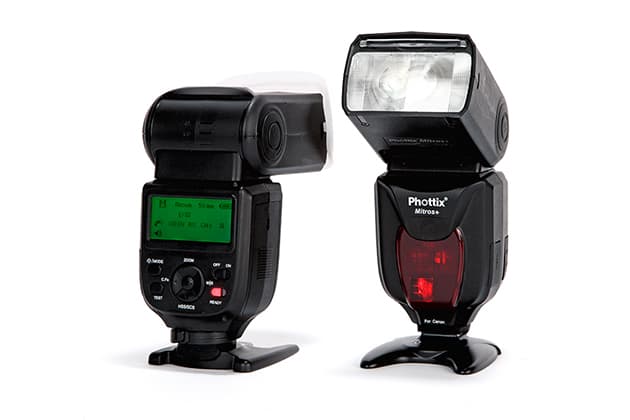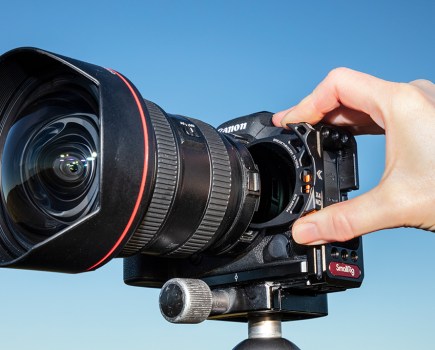
Phottix is a photographic accessories company that is well known for its flash triggering systems. The Strato Trigger system, which is a fairly standard 2.4GHz radio receiver and transceiver set-up intended to fire flashguns off-camera, gained popularity due to its fantastic build quality, durability and affordability. This was replaced by the current Phottix Strato II Multi, which has a more refined design and a few more features. Sitting above the Strato II Multi system is the Phottix Odin system. With a flashgun, or multiple flashguns, attached to the Odin receiver/s, this system gives photographers the ability to fire flashes off camera. It also offers the ability to adjust the power manually +/-3EV or use TTL metering, all handled by the Odin transceiver mounted on the camera’s hotshoe.
Earlier this year Phottix announced the Phottix Mitros+ flashgun that took the existing Mitros flashgun and integrated both the receiver and transceiver inside one flash unit. With its high guide number and impressive specification the Mitros+ has the power to rival any top competitor flashguns, at a more affordable price.
Phottix Mitros+ – Features
The built-in 2.4GHz frequency radio triggering system is one of two significant features of the Phottix Mitros+ flashgun. It allows the Mitros+ to be triggered off-camera without the need for any additional receiver attached.
The other highlight feature is the TTL metering, which is in effect an automatic setting for the flashgun with the added bonus that it also works off-camera. The TTL metering works by firing a preflash a fraction of a second before the camera takes a photograph. The camera then calculates how to expose the scene correctly and provide enough light in which to achieve a good exposure.

Using one Mitros+ in TTL mode modified with a Westcott Rapid Box softbox, shots need little manual adjustment
A flashgun with built-in radio triggering is not new technology; Canon has radio control inside its flagship flashgun, the Canon 600EX-RT. However, the Mitros+ has an advantage over the Canon ST-E3 trigger, coupled with the Canon 600EX-RT, as it’s also compatible with other lights. By adding Phottix Odin receivers, it’s possible to fire older flash units such as the Canon 580EX II with TTL or sync studio strobes alongside the Mitros+. The Phottix Strato system is also backward compatible, although this won’t feature the same TTL feature as the Odin.
Some Nikon and Sony flashguns have a built-in infrared system that allows them to be triggered by the camera. However, the disadvantage of this is that the flashes need to be in line-of-sight of the camera. This means they will not fire if positioned behind the camera or around corners, which can be a real issue on location. The Yongnuo YN-560 III offers a built-in radio control but it is fully manual and unlike the Mitros+, does not have TTL.
In short, the Mitros+ offers a more comprehensive flash triggering system than anything else currently available, with the added convenience of it all being built-in.
In addition to being a receiver, the Mitros+ Flash is also a transmitter. This means it can be used to trigger flashes with Phottix Odin receivers attached or other Mitros+ flashguns when the unit is mounted on the camera’s hotshoe. Older Phottix receivers can also be triggered, but without TTL metering. Just like the Odin transceiver, the TTL can be adjusted in third-of-a-stop increments to +/-3EV and each different flash can be assigned to either A, B, C group and to Channel 1, 2, 3 or 4. This allows users to control which one is a key light, fill light and background light when using multiple flashguns. However, as the Mitros+ has to be mounted to the hotshoe it means one less flash to be used off-camera, unless users want to shoot one flash on-camera and other flashes off-camera. The most sensible solution is to buy an Odin Transceiver alongside a Mitros+ as it costs half the price of the flash unit and means the flash can then be liberated from the confines of the hotshoe mount.
The Mitros+ flashes also feature Optical Slave Triggering – this allows the flash to be triggered by a pulse of light from any flash. This is particularly useful when shooting with studio strobe lights and the photographer wants quickly to add in a background light or something similar. However, it’s worth noting that if the triggering flashes used are in TTL, then the preflash used to meter the exposure will trigger the Mitros prematurely, and it will not fire on the final exposure.
The Mitros+ also offers High Speed Sync (HSS) and Second Curtain Sync (SCS). In HSS mode a shutter speed of 1/8000 is possible which is great for capturing action quickly. SCS fires the flash at the end of an exposure allowing users to shoot with slower shutter speeds and capture motion.
Four AA batteries supply the flashgun’s power and interestingly, in the top right corner of the flash’s display is a battery indicator. This is a small touch but it is a huge advantage to be able to tell how much power is left in the batteries, something I haven’t seen on any other flashgun.
The head zoom goes from 24-105mm, which is a comfortable range for most shooting situations. The head rotates 180° each way and up and down from 90° to -7°.
Included with the Mitros+ flashgun is a carry case and a coldshoe stand with tripod mount on the underside. There’s also a USB cable which connects to the flash to allow firmware updates, a 3.5mm sync cable, a USB drive with the instruction manual pre-installed, a port adapter for external power sources to be attached to the flash and a diffusion dome which clips over the front of the flash head.

This shot was taken with two flashes modified with a Westcott Rapid Box on the key light and a small 15in softbox for the fill light
Phottix Mitros+ – In use
I took a pair of Mitros+ flashes around in my kit bag for a couple of wedding shoots, a portrait session and an 18-day fishing trip. Throughout, the Mitros+ performed flawlessly. Never once did the flash misfire, which can be an issue with some radio-controlled systems.
Backwards compatibility is fantastic. I used two Canon 580EX II units attached to the Phottix Strato II Multi receivers alongside two Mitros+ flashguns, and was able to trigger them all at the same time for studio-style shooting on location.
Using Eneloop XX batteries, the recycle time on full power was a little over two seconds. When the batteries start to get too hot from continued use of high-powered flashes, there is an indicator in the top right corner that displays a ‘hot’ icon and reduces the recycle time to a safe recycle time. Usually this is around three seconds, but can take as long as six seconds if the flash is very hot.
Small touches like the battery indicator and an optional audible beep when the flash is recycled, show there has been a lot of thought put into the Phottix Mitros+. I found these little touches to be very useful.
Phottix Mitros+ – Our verdict
For event and wedding photographers, the Mitros+ flash will be a game changer. At a wedding, the TTL gave me the flexibility to move around a room shooting different people without having to worry about dialing in manual settings. What’s more, it’s so quick and simple I was able to get twice the number of shots. At a street price of just £400, its power output, zoom range and build quality is high enough to rival all flagship proprietary flashguns, and is more affordable, too. Offering the best functionality I’ve ever seen on a flashgun at such an affordable price makes the Phottix Mitros+ a must-have for anybody wanting to shoot with off-camera flash.
 SCORE: 5 out of 5
SCORE: 5 out of 5
Phottix Mitros+ specifications:
Flash coverage: 24-105mm
Head rotation: 180º left/right, 7º down, 90º up
Guide No: 50m at ISO 100 (105mm)
Recycling time: 0.1-5 sec
Power: 4 x AA
Dimensions: 203 x 78 x 58mm
Weight: 427g







